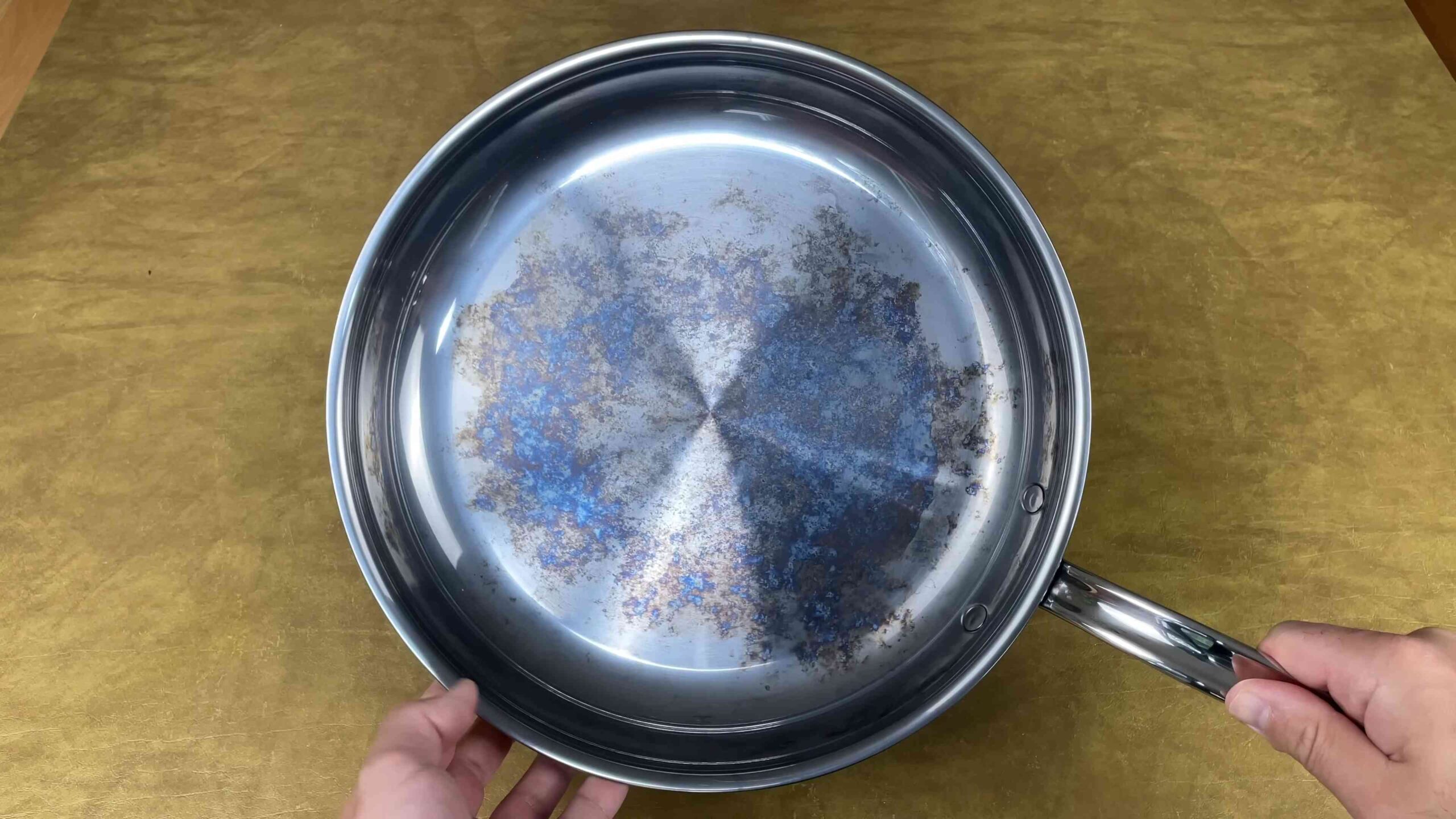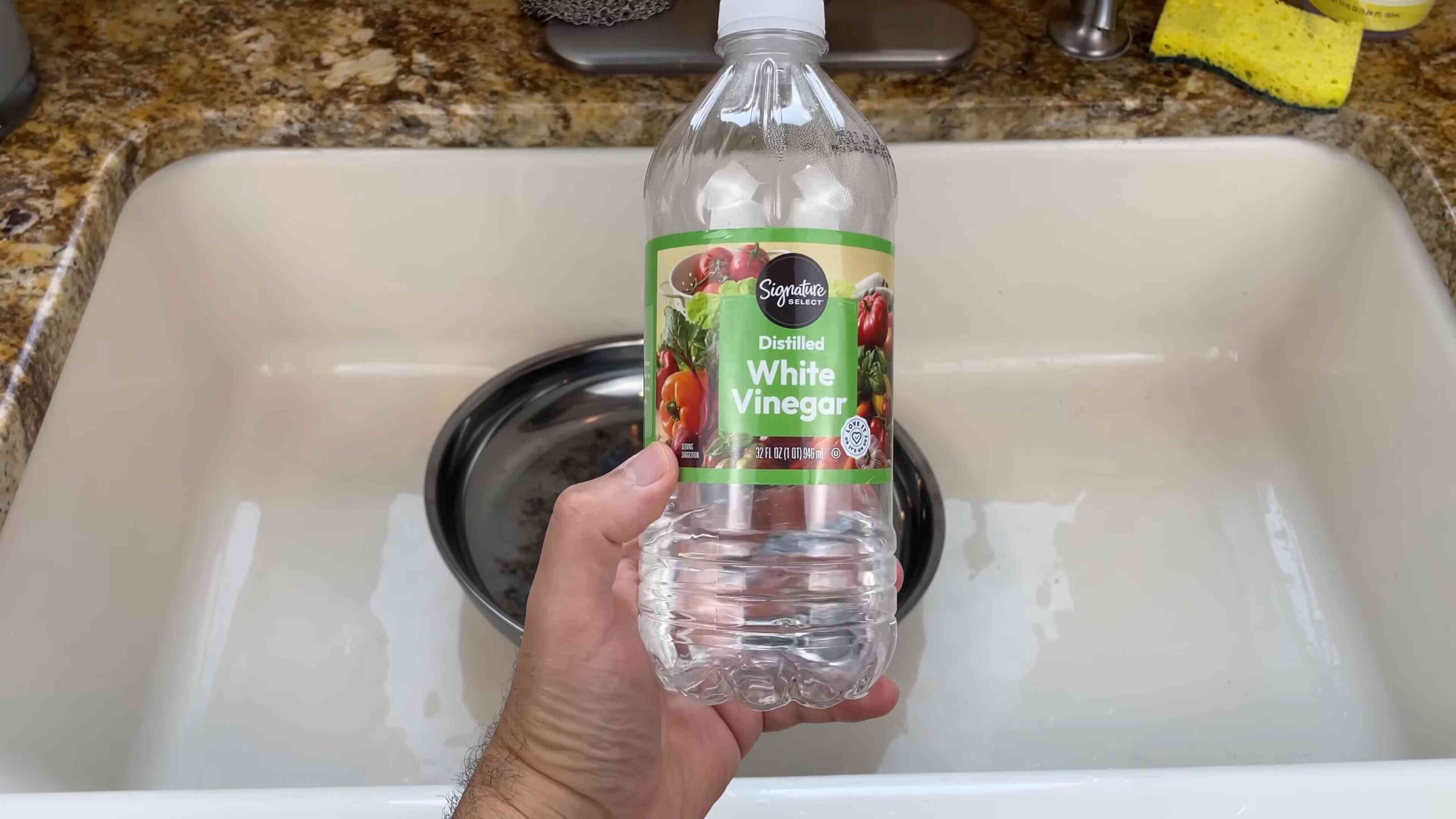Clean Stainless Steel with Vinegar: Are you tired of battling stubborn fingerprints, water spots, and that dull film that seems to cling to your stainless steel appliances? I know I was! For years, I struggled to keep my kitchen looking pristine, resorting to harsh chemicals that left behind a lingering odor and a nagging worry about their impact on my family and the environment.
The quest for a truly effective and eco-friendly cleaning solution led me down a path of discovery, revealing the incredible power of a humble household staple: vinegar. While vinegar has been used for centuries in various cultures for its cleaning and medicinal properties – dating back to ancient civilizations who utilized it for everything from preserving food to disinfecting wounds – its application for stainless steel cleaning is a relatively modern revelation.
Let’s face it, stainless steel is a beautiful and durable material, but its tendency to show every smudge and streak can be incredibly frustrating. That’s where this DIY trick comes in! I’m going to show you how to clean stainless steel with vinegar, achieving a sparkling, streak-free shine without the need for expensive and potentially harmful commercial cleaners. This simple hack will not only save you money but also contribute to a healthier and more sustainable home. Get ready to unlock the secret to effortlessly maintaining the beauty of your stainless steel!

DIY: Sparkling Stainless Steel with the Magic of Vinegar!
Hey there, fellow DIY enthusiasts! Are you tired of looking at dull, smudged stainless steel appliances? Do fingerprints and water spots seem to have taken permanent residence on your fridge, dishwasher, or sink? Well, fret no more! I’m here to share a super simple, incredibly effective, and budget-friendly way to bring back the shine using something you probably already have in your pantry: vinegar!
This method is fantastic because it avoids harsh chemicals, is environmentally friendly, and honestly, the results are amazing. I’ve been using this trick for years, and my stainless steel always looks brand new. So, let’s dive in and get those surfaces gleaming!
What You’ll Need:
Before we get started, let’s gather our supplies. The beauty of this DIY hack is that you don’t need a ton of fancy equipment. Here’s what you’ll need:
* White Vinegar: This is the star of the show! Distilled white vinegar is the best choice.
* Spray Bottle: A clean spray bottle is essential for even application.
* Microfiber Cloths: These are your best friends for streak-free cleaning. Avoid paper towels, as they can leave lint behind.
* Water (Optional): For diluting the vinegar if you have sensitive stainless steel or a strong aversion to the smell.
* Olive Oil (Optional): For adding an extra layer of shine and protection at the end.
* Another Clean Microfiber Cloth (Optional): If you choose to use olive oil.
Understanding the Process:
The key to cleaning stainless steel effectively with vinegar lies in understanding the direction of the grain. Stainless steel has tiny, almost invisible lines running in one direction. Cleaning *with* the grain prevents streaks and ensures a uniform shine.
* Identifying the Grain: Look closely at your stainless steel appliance. You should be able to see faint lines running either horizontally or vertically.
* Cleaning Direction: Always wipe in the same direction as the grain. This is crucial for achieving a streak-free finish.
Step-by-Step Instructions:
Alright, let’s get down to business! Follow these steps for sparkling stainless steel:
1. Prepare Your Vinegar Solution:
* Fill your spray bottle with undiluted white vinegar. If you’re concerned about the smell or have particularly sensitive stainless steel, you can dilute the vinegar with water (a 1:1 ratio is a good starting point). I usually use it straight, but it’s totally up to you!
2. Spray the Surface:
* Lightly spray the stainless steel surface with the vinegar solution. Don’t over-saturate it; a light mist is all you need. Make sure you cover the entire area you want to clean.
3. Wipe with the Grain:
* Using a clean microfiber cloth, wipe the surface in the direction of the grain. Apply gentle pressure and work your way across the entire area. Remember, consistency is key!
4. Buff Dry (If Necessary):
* In most cases, the vinegar will evaporate quickly, leaving a streak-free finish. However, if you notice any lingering moisture or streaks, use a dry, clean microfiber cloth to buff the surface until it’s completely dry. Again, wipe with the grain!
5. Repeat as Needed:
* For stubborn stains or heavily soiled areas, you may need to repeat the spraying and wiping process. Don’t be afraid to give it a second go!
6. Optional: Olive Oil Polish:
* For an extra layer of shine and protection, you can apply a small amount of olive oil to the stainless steel. Pour a tiny amount (seriously, a few drops!) onto a clean microfiber cloth.
* Rub the olive oil onto the surface, again working with the grain.
* Use a fresh, clean microfiber cloth to buff away any excess oil. This will leave a beautiful, protective sheen.
Dealing with Specific Issues:
Sometimes, you might encounter specific problems that require a little extra attention. Here are a few tips for tackling common stainless steel cleaning challenges:
* Hard Water Spots: Hard water can leave unsightly spots on your stainless steel. For these, I recommend using undiluted vinegar and letting it sit on the spots for a few minutes before wiping. You might need to scrub gently with a non-abrasive sponge if the spots are particularly stubborn.
* Grease Splatters: Grease can be a pain to remove. For greasy areas, try spraying the vinegar and letting it sit for a bit longer to help break down the grease. You can also add a drop of dish soap to your vinegar solution for extra cleaning power. Just be sure to rinse thoroughly with water and dry completely to avoid streaks.
* Burnt-On Food: If you have burnt-on food on your stainless steel cookware, try soaking the pot or pan in a solution of vinegar and water for a few hours before attempting to scrub it clean. You can also boil a mixture of vinegar and water in the pot to help loosen the burnt-on food.
* Fingerprints: Fingerprints are probably the most common annoyance on stainless steel. The vinegar method works wonders for removing them! Just a quick spray and wipe with a microfiber cloth, and they’re gone.
Important Considerations:
While vinegar is generally safe for stainless steel, there are a few things to keep in mind:
* Test in an Inconspicuous Area: Before cleaning your entire appliance, test the vinegar solution in a small, hidden area to ensure it doesn’t damage the finish. This is especially important for older or more delicate stainless steel.
* Avoid Abrasive Cleaners: Never use abrasive cleaners, steel wool, or scouring pads on stainless steel, as they can scratch the surface.
* Rinse Thoroughly (If Using Soap): If you add dish soap to your vinegar solution, be sure to rinse the surface thoroughly with water to remove any soap residue.
* Dry Completely: Always dry the stainless steel surface completely after cleaning to prevent water spots.
Maintaining Your Sparkling Stainless Steel:
Once you’ve achieved that beautiful shine, you’ll want to keep it that way! Here are a few tips for maintaining your stainless steel:
* Wipe Up Spills Immediately: Don’t let spills sit on your stainless steel for too long, as they can cause stains.
* Regular Cleaning: Clean your stainless steel appliances regularly to prevent buildup of dirt and grime. A quick wipe down with vinegar once a week can make a big difference.
* Use a Stainless Steel Cleaner (Occasionally): While the vinegar method is great for everyday cleaning, you can also use a commercial stainless steel cleaner occasionally for a deeper clean. Just be sure to follow the manufacturer’s instructions.
Why This Works: The Science Behind the Shine
Vinegar’s cleaning power comes from its acidity. Acetic acid, the main component of vinegar, is a mild acid that can dissolve mineral deposits, grease, and grime. It’s also a natural disinfectant, which helps to kill bacteria and germs. The microfiber cloths are essential because they are designed to trap dirt and grime without scratching the surface, leaving a streak-free finish. The optional olive oil adds a protective layer that helps to repel fingerprints and water spots, keeping your stainless steel looking cleaner for longer.
My Personal Experience:
I’ve been using this vinegar cleaning method for years, and I’m always amazed at how well it works. My stainless steel appliances look brand new, and I love that I’m using a natural and affordable cleaning solution. I especially appreciate that it’s safe for my family and pets. I’ve tried countless commercial stainless steel cleaners, and none of them have given me the same results as vinegar. Plus, it’s so much cheaper! I highly recommend giving this DIY hack a try. You won’t be disappointed!
So there you have it! A simple, effective, and budget-friendly way to clean your stainless steel appliances with the magic of vinegar. Give it a try, and let me know what you think! Happy cleaning!

Conclusion
So, there you have it! This simple, yet incredibly effective, DIY trick for cleaning stainless steel with vinegar is a game-changer for anyone looking to achieve a streak-free, sparkling finish without resorting to harsh chemicals or expensive commercial cleaners. We’ve walked you through the process, highlighting the ease and affordability of using a common household ingredient like vinegar to tackle stubborn fingerprints, water spots, and grime.
Why is this a must-try? Because it’s not just about cleaning; it’s about simplifying your life and making conscious choices for a healthier home. You’re reducing your exposure to potentially harmful chemicals, saving money, and contributing to a more sustainable lifestyle, all while achieving professional-level cleaning results. It’s a win-win-win!
But the beauty of this method lies in its adaptability. While we’ve focused on using white vinegar, you can experiment with other types of vinegar, such as apple cider vinegar, although white vinegar is generally preferred for its neutral scent and cleaning power. For extra stubborn stains, consider pre-treating the area with a paste of baking soda and water before applying the vinegar solution. This gentle abrasive action can help loosen the grime and make it easier to wipe away.
Another variation to consider is adding a few drops of your favorite essential oil to the vinegar solution. This not only adds a pleasant fragrance but can also provide additional cleaning and disinfecting benefits. Lemon, tea tree, and eucalyptus essential oils are all excellent choices for their antibacterial and antiviral properties. Just be sure to use pure essential oils and test a small, inconspicuous area first to ensure they don’t react negatively with your stainless steel.
We are confident that once you try this DIY trick for cleaning stainless steel with vinegar, you’ll be amazed by the results. It’s a simple, effective, and eco-friendly way to keep your stainless steel appliances and surfaces looking their best.
Now, we want to hear from you! Give this method a try and share your experience with us in the comments below. Did you find it as effective as we did? Did you experiment with any variations? What tips and tricks did you discover along the way? Your feedback is invaluable and helps us create even better content for our community. Let’s work together to make our homes cleaner, healthier, and more sustainable, one stainless steel surface at a time!
Frequently Asked Questions (FAQs)
1. Why is vinegar effective for cleaning stainless steel?
Vinegar, particularly white vinegar, is a mild acid that effectively cuts through grease, grime, and hard water stains. Its acidity helps to dissolve mineral deposits and soap scum that can accumulate on stainless steel surfaces. Furthermore, vinegar is a natural disinfectant, helping to kill bacteria and germs, leaving your stainless steel clean and hygienic. The key is to dilute the vinegar with water to prevent any potential damage to the stainless steel finish.
2. Will vinegar damage my stainless steel appliances?
When used properly and diluted with water, vinegar is generally safe for cleaning stainless steel. However, it’s crucial to avoid using undiluted vinegar, as the high acidity could potentially etch or dull the surface over time. Always test the diluted vinegar solution on a small, inconspicuous area first to ensure it doesn’t cause any discoloration or damage. Also, avoid using vinegar on stainless steel that has a protective coating or sealant, as it may strip away the coating.
3. What is the best way to dilute vinegar for cleaning stainless steel?
The recommended dilution ratio is typically a 50/50 solution of white vinegar and water. This provides a good balance of cleaning power and safety for your stainless steel surfaces. You can adjust the ratio slightly depending on the severity of the stains or grime. For light cleaning, you can use a weaker solution, while for tougher stains, you may need a slightly stronger solution.
4. Can I use other types of vinegar besides white vinegar?
While white vinegar is generally preferred for cleaning stainless steel due to its neutral scent and effective cleaning properties, you can also use other types of vinegar, such as apple cider vinegar. However, be aware that apple cider vinegar has a stronger scent that some people may find unpleasant. It’s also important to ensure that the vinegar is properly diluted to prevent any potential damage to the stainless steel.
5. What kind of cloth should I use to clean stainless steel with vinegar?
Microfiber cloths are the best choice for cleaning stainless steel with vinegar. They are soft, absorbent, and non-abrasive, which helps to prevent scratches and streaks. Avoid using abrasive scrub pads or steel wool, as these can damage the stainless steel finish. You can also use a soft cotton cloth, but microfiber cloths tend to be more effective at removing dirt and grime without leaving streaks.
6. How often should I clean my stainless steel appliances with vinegar?
The frequency of cleaning depends on how often you use your stainless steel appliances and how prone they are to getting dirty. For appliances that are used frequently, such as refrigerators and dishwashers, you may want to clean them once a week. For appliances that are used less often, such as ovens and microwaves, you can clean them every few weeks or as needed. Regular cleaning will help to prevent the buildup of grime and stains, making it easier to maintain the appearance of your stainless steel appliances.
7. What if vinegar doesn’t remove all the stains on my stainless steel?
For stubborn stains that vinegar alone cannot remove, you can try using a paste of baking soda and water. Apply the paste to the stain, let it sit for a few minutes, and then gently scrub with a soft cloth. Rinse with water and dry thoroughly. You can also try using a commercial stainless steel cleaner, but be sure to choose one that is specifically designed for stainless steel and follow the manufacturer’s instructions carefully.
8. How do I prevent streaks when cleaning stainless steel with vinegar?
To prevent streaks, always wipe the stainless steel in the direction of the grain. The grain is the faint lines that run along the surface of the stainless steel. Wiping in the direction of the grain will help to avoid leaving streaks and ensure a more even finish. Also, be sure to use a clean, dry microfiber cloth to buff the surface after cleaning.
9. Can I use vinegar to clean stainless steel sinks?
Yes, vinegar is an excellent choice for cleaning stainless steel sinks. It can help to remove water spots, soap scum, and food stains. Simply spray the sink with a diluted vinegar solution, let it sit for a few minutes, and then scrub with a soft cloth or sponge. Rinse with water and dry thoroughly.
10. Is it safe to use vinegar to clean the inside of my stainless steel appliances?
While vinegar is generally safe for cleaning the exterior of stainless steel appliances, it’s important to exercise caution when cleaning the interior. Avoid using vinegar on heating elements or electrical components. For cleaning the interior of ovens or microwaves, you can use a diluted vinegar solution, but be sure to rinse thoroughly with water to remove any residue. Always consult the manufacturer’s instructions for specific cleaning recommendations for your appliances.





Leave a Comment